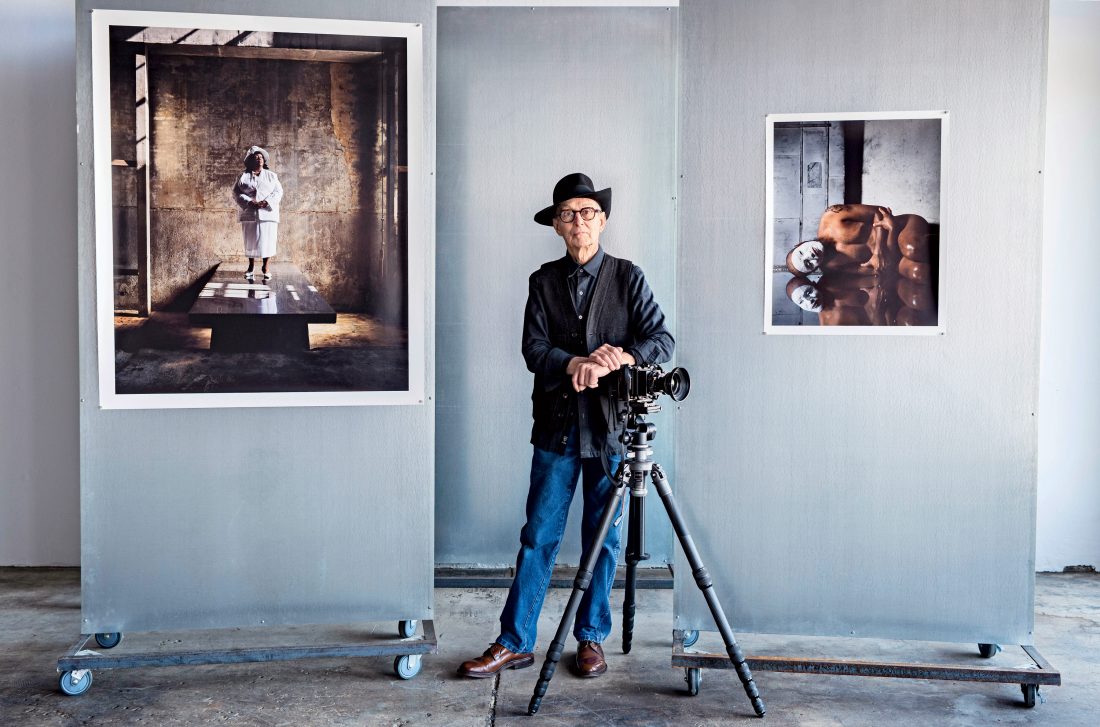The sound of a passing train fills Burk Uzzle’s studio in downtown Wilson, North Carolina. Only a block and a half from the tracks, the building has at times been used for such disparate small-town enterprises as selling cars and making coffins. These days it’s home to something much more unexpected: one of the nation’s most celebrated photographers.
“There’ve been so many parts to my life,” Uzzle says, in succinct understatement, struggling to sum up an expansive career. He is perhaps best known for his documentation of the social upheaval of the 1960s, including the iconic photo on the cover of the Woodstock live album (a couple holding each other under a muddy quilt) and his heartbreaking shot of a despondent mourner beside Martin Luther King, Jr.’s open coffin. Recent decades have seen him focus less on photojournalism and more on a wider social landscape that, through Uzzle’s lens, appears at once utterly familiar and surprising. This summer, his sixty years of photographing American life will be celebrated in a collaborative retrospective mounted by three of North Carolina’s premier museums—the Ackland Art Museum at the University of North Carolina in Chapel Hill, the Nasher Museum of Art at Duke University, and Raleigh’s North Carolina Museum of Art.
Born in 1938 in Raleigh, Uzzle got his start as an eighteen-year-old staff photographer for the News & Observer. By the time he was twenty-three, Life magazine had brought him on as its youngest photographer ever. He would go on to shoot for Magnum Photos—the legendary photographers’ cooperative cofounded by one of Uzzle’s mentors, Henri Cartier-Bresson—and has spent the past three decades operating as an independent. And though Uzzle has photographed seemingly every corner of the country, and indeed much of the world, his global experiences seem only to have reinforced his interest in those regions closer to his birthplace. Much of his recent work has focused on the South. Directed by his gaze, we find ourselves pondering a plain suburban yard filled with fluorescent crab pots, a small white church at the edge of a clear-cut field, and a stream running past a bank of moss-covered cars.
Photo: Burk Uzzle
Just Before His Own Death (1968)
1 of 5
Photo: Burk Uzzle
Woodstock (cover, Ercolines) (1969)
2 of 5
Photo: Burk Uzzle
Clear Cut Church, North Carolina (2006)
3 of 5
Photo: Burk Uzzle
Bicycle Tree (2006)
4 of 5
Photo: Burk Uzzle
The body of Martin Luther King, in the Funeral Home in Memphis (1968)
5 of 5
“I grew up in North Carolina and have always been fascinated by the landscape and the people,” Uzzle says. After having lived away from the state for nearly fifty years, he returned in 2007. “I kept missing it, and I thought, ‘I’m going to move back to North Carolina and shoot where I’m from.’”
His work, he says, is often marked by “a sense of whimsy, humor, and the graphic sense of my eye.” And though many of his photos share this unifying aesthetic vision, they cover such a wide spectrum that it only made sense to the museums’ directors that they collaborate, with each venue’s exhibition focusing on a different facet of Uzzle’s career. The Ackland will publish an accompanying book on the photographer.
“My interests come from who I am—where I grew up and where my sensibilities lie,” Uzzle says, considering a lifetime of work. But no matter the subject, a single driving purpose has directed it all: “I’ve always lived for the picture.”













